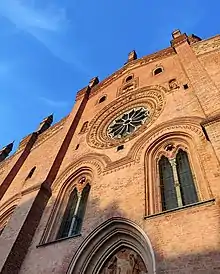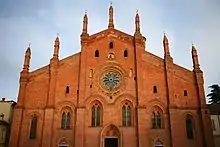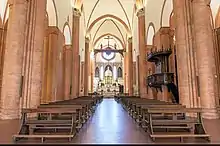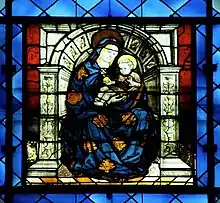Santa Maria del Carmine, Pavia
Santa Maria del Carmine is a church in Pavia, Lombardy, northern Italy, considered amongst the best examples of Lombard Gothic architecture. It was begun in 1374 by Gian Galeazzo Visconti, Duke of Milan, on a project attributed to Bernardo da Venezia. The construction followed a slow pace, and was restarted in 1432, being finished in 1461.

| Church of Our Lady of Mount Carmel | |
|---|---|
 Façade. | |
| Religion | |
| Affiliation | Catholic |
| Province | Pavia |
| Year consecrated | 1374 |
| Status | Active |
| Location | |
| Location | Pavia, Italy |
| Architecture | |
| Type | Church |
| Style | Gothic |
| Completed | 1490 |
History
Starting from 1373 the Carmelites started the construction of the new church which lasted for over a century. In 1390 Gian Galeazzo donated a large donation for the construction of the church, however, again in the same years, the beginning of the construction of the Certosa di Pavia caused a slowdown in the works, because many workers were attracted to the new construction site. The convent was suppressed in 1799 and the church was transformed into a parish.[1]

Architecture
The church has an imposing façade commanding the square with the same name; the slender forms betray a residual Romanesque influence, although the decorations are undoubutably of Lombard Gothic style. The façade is divided into five vertical compartments by six pilasters surmounted by spires. The three central sectors have a portal each, remade by Giuseppe Marchesi in 1854. Over the portals are four large ogival mullioned windows and an elaborated rose window in brickwork.
_10.jpg.webp)
The central part is occupied by a very elaborate terracotta rose window. The central rose window has a large decorated frame in terracotta which contains, in the outermost part, heads of angels. The upper profile is decorated with a frieze and seven square pinnacles. On the sides of the rose window there are two niches that house the statues of the archangel Gabriel and the Virgin of the Annunciation. Above the rose window, a niche surrounded by a square frame contains a terracotta bas-relief depicting the Eternal Father. These statues are stylistically attributable to the ambit of Giovanni Antonio Amadeo.[2]
The church has a rectangular plan within which there is a Latin cross plan with three naves flanked by square chapels obtained from the remodeling of the outermost aisles (originally the layout had five naves). The plan dimensions are considerable: almost 80 meters long by 40 wide. The large size of the church is linked to belonging to the Carmelites, an order of preaching friars.[3] The proportions of the construction are based on the module ad quadratum, which involves the use of a single square base element which is repeated in width, length and height.[4] The central nave, twice the height of the smaller ones, is subdivided into four square bays which, in the side aisles, are in turn subdivided into two square bells open on two chapels, always with a square plan. The vaults are cross arched and the ribs that divide the structure of the vaults are in terracotta to form a chromatic element in contrast with the light plaster. The pillars also feature a chromatic combination with terracotta and gray Angera stone.[5]
The bell tower, dating to c. 1450, it stands elegantly over the city; it is adorned with numerous friezes and characterized by a mullioned window adorned with marble columns. With its 75 m high it is the highest bell tower in Pavia.[6]
Interior
The interior is characterized by an inspiring penumbra, and is on the Latin cross plan with a nave and numerous lateral chapels with frescoes and paintings. The most important are:
- 2nd Chapel, with a fresco by Vincenzo Foppa (1462)
- 4th Chapel, with a canvas of the Guardian Angel by Sebastiano Ricci (1694)[7]
- 5th Chapel, with an Assumption by Bernardo Cane and a canvas with "St. Augustine writes on the heart of Maria Maddalena de 'Pazzi" by Pietro Maggi
- 6th Chapel, with an altarpiece of St. Anne and the Wool Making Craft (by Guglielmo Caccia) and with the "Vision of Pope Honorius III" by Filippo Abbiati
- 7th Chapel, housing a Gothic altarpiece donated by Pius X, and 15th century polyptych with Madonna and Saints (by Bernardino da Cotignola).[8]
In the apse wall, above the altar there is a polychrome stained glass window depicting the Madonna enthroned with the Child, made between 1482 and 1489. The cartoon with the Madonna has been attributed to Vincenzo Foppa. The fifteenth-century tile is the only one left of the original stained-glass window that had been re-glazed in 1827. During the restoration in 1989, the fifteenth-century tile, placed in the center, with the Madonna enthroned and the Child was inserted in a new frame, a rhombus electric blue with rounded corners in turn inscribed in the large circle of the rose window with modern geometric motifs.[9] Above the altar, the triumphal arch of the church is enriched by a large wooden iconostasis with Jesus crucified and, at its sides, the Madonna and San Giovanni Evangelista, the work of Giovanni Battista Trucazzano, built between 1638 and 1645.[10]

In the transept on the left wall there are numerous and precious votive frescoes attributed to the circle of Michelino da Besozzo and dated between the first and fourth decade of the fifteenth century, and an altarpiece by Bernardino Lanzani with the Child Jesus between the Madonna, the SS. Anna, Joachim, John the Evangelist, signed and dated (1515).
On the right side wall of the transept there is the facade, rich in Baroque stuccoes, of the sacristy (1576), built by Count Camillo Pietra. Around the portal that gives access to the room there are symmetrical niches with St. Francis with the stigmata and John the Baptist, while the niche in the tympanum houses the Virgin and Child.[11]
_04.jpg.webp)
In the counter-façade there is a painting from the second half of the fifteenth century depicting Our Lady of Graces between Saint Julius of Novara and Saint Anthony the Great within a sixteenth-century architectural frame in carved gilded wood. Popular devotion attributed miraculous powers to the painting and anecdotes and legends were born around it. To the right of the painting there is a fresco (dating back to the second half of the sixteenth century) enclosed in a painted gilded frame that incorporates the wooden cave which has five depictions of the miracles that this Madonna would have performed. Among these is the rescue from a shipwreck in the Ticino in flood.[12]
_11.jpg.webp)
References
- "Chiesa di Santa Maria del Carmine, complesso". Lombardia Beni Culturali. Retrieved 31 July 2022.
- "Chiesa di Santa Maria del Carmine". Lombardia Beni Culturali. Retrieved 31 July 2022.
- Mazzilli Savini, Maria Teresa (1996). "L'architettura gorica pavese". storia di Pavia. Milano: Banca Regionale Europea. pp. 480–486.
- Mazzilli Savini, Maria Teresa (2009). Architetture medievali e strade. Itinerari nella lombardia occidentale. Palermo: Dario Flaccovio Editore. pp. 209–210. ISBN 9788877588647.
- "Chiesa di Santa Maria del Carmine". Lombardia Beni Culturali. Retrieved 31 July 2022.
- "Campanile della chiesa di Santa Maria del Carmine". Lombardia Beni Culturali. Retrieved 31 July 2022.
- Zatti, Susanna (1995). "Le arti a Pavia nel XVII e XVIII secolo". Storia di Pavia. Milano: Banca Regionale Europea. pp. 915–916.
- "Chiesa di Santa Maria del Carmine". Lombardia Beni Culturali. Retrieved 31 July 2022.
- "Vetrata". Lombardia Beni Culturali. Retrieved 31 July 2022.
- "Chiesa di Santa Maria del Carmine". Lombardia Beni Culturali. Retrieved 31 July 2022.
- "Chiesa di Santa Maria del Carmine". Lombardia Beni Culturali. Retrieved 31 July 2022.
- "Chiesa di Santa Maria del Carmine". Lombardia Beni Culturali. Retrieved 31 July 2022.